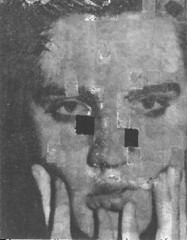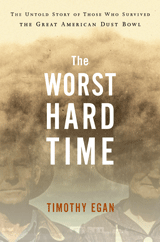Some like it shot.
McGonigal scores again with another great all-over-the-place post that ranges from the rare and rarefied song he presents (Happy Cat, "We Fuck You Like Supermen"), to Andre Breton, to how he met the artist Nancy Spero, and her late husband, artist Leon Golub, finishing up with a well-placed jab at the NYTimes, which saw fit to highlight, among several stoopid articles that appeared in her august pages over the weekend, the hot topic that is bands covering other bands.
His art gab is enough to motivate me to finally plug a documentary I caught on cable a few weeks ago --- How to Draw a Bunny, on the late artist Ray Johnson. Johnson, whose 1995 suicide was the last act in a life lived as art, was infamously known as "New York's most unknown famous artist" --- the consummate art insider. I first came to Johnson via a 1999 retrospective at the Whitney Museum, the Artforum review of which can be found here.
Though his mail art (Johnson was founder of the New York Correspondence School, the granddaddy of mail art orgs) and intricate collages and fluxus happenings are not best displayed in vitrines, and though his relationship to the art firmament was complicated (“Dear Whitney Museum, I hate you. Love, Ray Johnson” goes one letter, which looks even better than it reads), the show was spectacularly eye-opening. How had I missed this guy? and I love this guy! were my two main responses. If you like Joseph Cornell’s stuff, you’ll probably groove on at least some of Johnson’s oeuvre; he’s like Cornell, only more prickly, more interactive, more impatient. Less boxy. If you’re a Dylan fan, you’ve probably seen his work on this book cover. If you’re an Elvis fan, you may have seen his work on this book cover.
In the end, the doc provides a good overview of an otherwise under-known figure, but tries a bit too hard to be coy, works a little too furiously to capture some of Johnson's attitude. And while the soundtrack provided by Max Roach’s solo drums works well initially, the frequent cutaways to his hands are cumulatively distracting. The best places online to see Johson’s work are the Feigen Gallery’s site, which has mostly late period work, and this page called the Ray Johnson Gallery, which features his mail art. Also highly recommended is the catalog that accompanied the Whitney show, which is a model of the form, and includes a revealing interview with the artist. As revealing as he allows, anyway.
The catalog is called Ray Johnson: Correspondences, and the title brings to mind Lawrence Weschler (again; see below), whose series of convergences have appeared in many issues of McSweeney's and elsewhere, and who would probably make great hay out of Johnson's textuality and shifting meanings. Weschler has written two books on artists, one on Robert Irwin, and one on J. S. G. Boggs (who, like Johnson, made the negotiation for his artwork part of the art itself), and it would be fascinating to see his take on Johnson. Seems unlikely, given Weschler's apparent need to spend time with his subjects, but I can't help thinking up projects for the man.
His art gab is enough to motivate me to finally plug a documentary I caught on cable a few weeks ago --- How to Draw a Bunny, on the late artist Ray Johnson. Johnson, whose 1995 suicide was the last act in a life lived as art, was infamously known as "New York's most unknown famous artist" --- the consummate art insider. I first came to Johnson via a 1999 retrospective at the Whitney Museum, the Artforum review of which can be found here.
Though his mail art (Johnson was founder of the New York Correspondence School, the granddaddy of mail art orgs) and intricate collages and fluxus happenings are not best displayed in vitrines, and though his relationship to the art firmament was complicated (“Dear Whitney Museum, I hate you. Love, Ray Johnson” goes one letter, which looks even better than it reads), the show was spectacularly eye-opening. How had I missed this guy? and I love this guy! were my two main responses. If you like Joseph Cornell’s stuff, you’ll probably groove on at least some of Johnson’s oeuvre; he’s like Cornell, only more prickly, more interactive, more impatient. Less boxy. If you’re a Dylan fan, you’ve probably seen his work on this book cover. If you’re an Elvis fan, you may have seen his work on this book cover.
In the end, the doc provides a good overview of an otherwise under-known figure, but tries a bit too hard to be coy, works a little too furiously to capture some of Johnson's attitude. And while the soundtrack provided by Max Roach’s solo drums works well initially, the frequent cutaways to his hands are cumulatively distracting. The best places online to see Johson’s work are the Feigen Gallery’s site, which has mostly late period work, and this page called the Ray Johnson Gallery, which features his mail art. Also highly recommended is the catalog that accompanied the Whitney show, which is a model of the form, and includes a revealing interview with the artist. As revealing as he allows, anyway.
The catalog is called Ray Johnson: Correspondences, and the title brings to mind Lawrence Weschler (again; see below), whose series of convergences have appeared in many issues of McSweeney's and elsewhere, and who would probably make great hay out of Johnson's textuality and shifting meanings. Weschler has written two books on artists, one on Robert Irwin, and one on J. S. G. Boggs (who, like Johnson, made the negotiation for his artwork part of the art itself), and it would be fascinating to see his take on Johnson. Seems unlikely, given Weschler's apparent need to spend time with his subjects, but I can't help thinking up projects for the man.






2 Comments:
Reason to rent the DVD: several fascinating interviews that didn't make the final cut. Real reason to rent the DVD: the crazy extensive photo gallery of Johnson's work which made me wonder why the fuck the Whitney missed so many of his great works! And I loved that Whitney show, even.
it's impressive, how mail art persists in the "digital era". and it's soothing too (for the eyes, namely).
(i've just written about mail art on new-art.blogspot.com)
Post a Comment
<< Home